Equity & Diversity Annual Report – 2002 2. Workplace Diversity Plan 2001–2005
The Bank announced its formal commitment to equal employment opportunity in May 1984 and since then has implemented and reported on six plans to progressively achieve the objectives of its EEO program. The program is intended to encourage good personnel management practices for all staff, while meeting legal obligations for the designated groups. The Bank's previous plan, 2000/01, recognised the diversity of the Bank's staff and sought to accommodate that diversity within broader Bank objectives regarding recruitment and selection, staff training and development and conditions of employment.
The development of the new plan involved assessing the Bank's policies and performance against the requirements of the Equal Employment Opportunity (Commonwealth Authorities) Act 1987, as well as principles endorsed in the Public Service Act 1999, the Equal Opportunity for Women in the Workplace Act 1999 and the Human Rights & Equal Opportunity Commission's Best Practice Guidelines. Accordingly, the Workplace Diversity Plan 2001–2005 reflects changing trends, new legislative directions and places greater emphasis on diversity management.
The areas for action identified in the new plan include – Gender; Work Life Balance; Indigenous Australians; Race-Ethnicity; and People with Disabilities. A first-stage initiative of the plan was to compile a comprehensive workplace profile covering designated groups, age and tenure, residential location, qualifications, and management composition. This profile is to provide a basis for analysing the effectiveness of the Plan and identifying further initiatives. To facilitate this process, copies of the profile will be given to Diversity Contact Managers.

Gender Diversity & Age Profiles
There has been a significant decline in staff numbers over the past decade, much of which has been concentrated in the Bank's branches. Over the past year or two, change has been more incremental. For the first time since 1986, overall staff numbers increased this year. However, this was not reflected in the percentage representation of women, which declined by 2% from 2001.
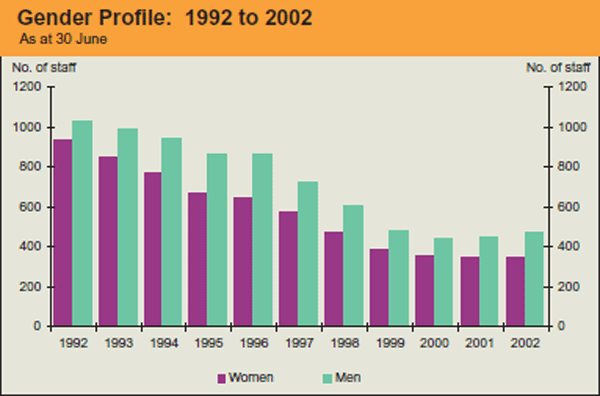
Women's representation in management has steadily increased over the past 10 years. The slight decline during the past 12 months occurred against a background of an overall increase in the number of management positions.
Representation of people from non-English speaking backgrounds (NESB1) in the workplace has continued to increase.
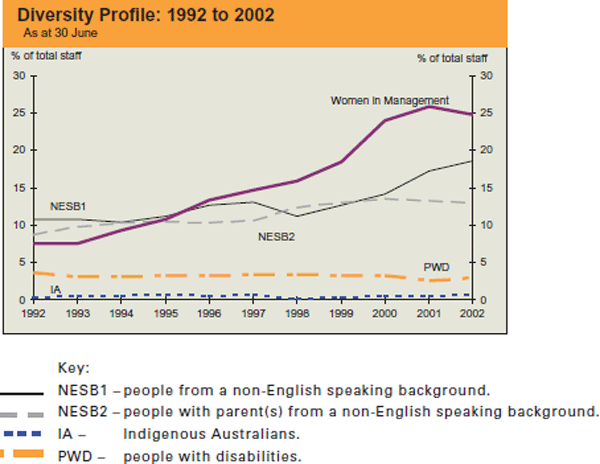
Age distribution and length of service data show little change from last year. 46% of the Bank's population is under 35 years of age; nearly 50% of women are under 35 compared to 43% of men. The Bank's median age in 2002 is 37, similar to the broader community[^] (35 years) and younger than the Australian Public Service[*] (42 years).
Half of all Bank staff have less than 10 years service while 22% have over 20 years service.
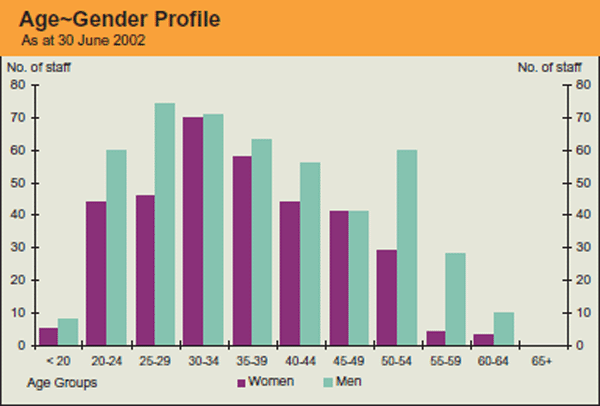
2.1 Gender
Impact of Salary Packaging
In recent years, the Bank has benchmarked the responsibilities and remuneration of executive, managerial, professional and clerical staff. Subsequently, individual employment contracts, which provide a degree of flexibility in remuneration, were offered to staff. The approach has been particularly successful in targeting staff with marketable skills. The change to individual contracts has been voluntary. Staff who declined the offer of contract employment have retained their existing conditions. The take-up on contracts was highest in the managerial and professional groups, both for men and women.
| Occupational Group | Women | Men | Total |
|---|---|---|---|
| Managers | 9 | 82 | 91 |
| Professionals | 22 | 50 | 72 |
| Associate Professionals | 8 | 38 | 46 |
| Clerical* | 5 | 4 | 9 |
| As at 30 June 2002 * Includes advanced and intermediate clerical staff. |
|||
Pay Equity
Australian Bureau of Statistics (ABS) data indicate that women earn on average 84% of what men earn. The Bank's experience is broadly consistent with that finding. Analysis of pay equity data for the Bank for the past five years indicates that it is occupational segregation – women highly represented in clerical positions relative to management positions – and unequal workforce participation, that are the major contributing factors. This is consistent with the data obtained in workplace reports submitted to the Equal Opportunity for Women in the Workplace Agency.
Internal Transfers by Functional Group
Over the past five years, internal transfers notified formally via the Bank's Vacancies & Appointments Circular have declined from 136 in 1997/98 to 56 this year. Further analysis of this data will be undertaken during the next reporting period to identify any emerging trends. In the current reporting period, the overall transfer rate gap between women and men has narrowed. Compared to last year's data, the transfer rate for women has remained the same at 8%, whilst the rate for men has declined from 13% to 7%.
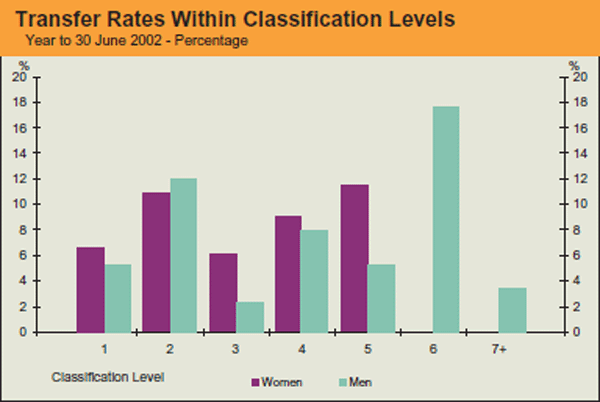
Occupational Groups & Gender Representation
The Bank continues to monitor gender representation in the various occupational groups, as well as changes in occupational structure over time. The two main occupational groups are clerical and professional. As the chart shows, 50% of all women are in clerical positions. This is a 2% decline from last year. By contrast, there has been a 3% increase in women in professional positions to 37%.
Of total Bank staff, 30% are now engaged in clerical occupations compared to 50% five years ago (refer Appendix 3.3). 70% of these positions are held by women, compared to 68% last year. Professional occupations accounted for 47% of total Bank staff. While this reflected an increase in the percentage of professional positions overall, the proportion of these positions held by women decreased slightly to 33%, compared to 34% last year.
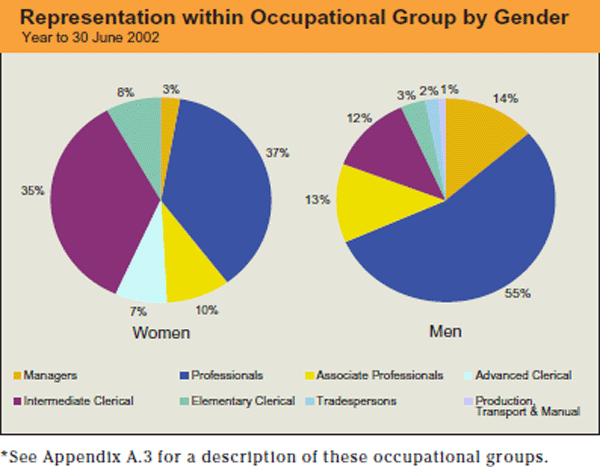
Graduate Recruitment Gender Ratio
Typically, women comprise around 30–40% of the Bank's graduate recruits (36% in 2002). The Bank recognised some years ago that there is a scarcity of female economic graduates. Since then, it has sought to benchmark the Bank's female graduate intake against the gender ratio of economic enrolments at universities. Each year, the Bank collects gender statistics on its graduate recruitment intake and conducts analysis of the recruitment process. As in previous years, the proportion of female graduate recruits for 2002 was similar to the gender ratio of relevant university enrolments. Throughout the selection process, applicants were tracked to ensure merit principles were applied.
Women in Management
Although the percentage of management positions held by women has declined over the last two reporting periods it is currently at 23%, significantly higher than the 8% recorded a decade ago. One area for action identified in the Bank's Workplace Diversity Plan involves attracting and retaining female graduates, and in time, increasing the number of women in management positions.
2.2 Work Life Balance
Flexible Work Arrangements
A new intranet page has been developed to promote the Bank's flexible work arrangements. It includes information on the Bank's part time work options for staff, rostered day scheme, half hour lunch breaks available to staff with caring responsibilities (to enable a later start or earlier finish time), parental leave, carer's leave, and links to relevant external sites provided by the Commonwealth Government. These include the Child Care Hotline, Elder Care information, Families portal and Youth portal for federal government information and services. Quarterly statistics on site activity will help ensure continuing relevance.
Carer's Leave
An initiative introduced in 2000 – carer's leave on a full or half day basis – has been well received with 39% of staff using this leave type during the year. This represented a 2% increase in usage of carer's leave during the past year. The entitlement is 5 full days per calendar year (pro-rata for part time staff) and the total average days taken was 2.5.
Part Time Work
The Bank provides various part time work options and these are to be revised into a more user-friendly format. The numerous labels attached to part time work in the Bank, for example, part time work contiguous with parental leave (PTWCPL), temporary part time work (TPTW) and permanent part time work (PPTW), have caused confusion over options available. New arrangements for part time work, including a new information pack for staff, are scheduled for release during the next reporting period.
Changes to parental leave arrangements, effective 1 January 2000, provided a guaranteed six months part time work with an option to extend up to a year. An analysis of part time work over the past 12 months has shown increasing use of flexible work options. Overall, 35 women worked part time during the year, in permanent and temporary arrangements.
Although it is too early to say, it could be that this initiative introduced in 2000 is providing an opportunity for on-going part time work not previously available. During the next reporting period, the Bank will continue to track the usage of part time work to gain a better understanding of the demand for this option.




Flexible work has included job sharing and part time work after parental leave.
Parental Leave
The Bank introduced paid parental leave – fourteen weeks for women and one week for men – in February 1974. The chart on the following page shows paid parental leave taken by both genders over the past five years. During the current reporting period, there were 22 women and 15 men.
Statistics for women completing parental leave have previously been reported as a percentage of staff. This year the Bank is reporting by number of staff to provide a more accurate picture of actions taken by staff at the end of parental leave. Of the 21 women completing parental leave this year, 8 resigned (including 3 who were retrenched).
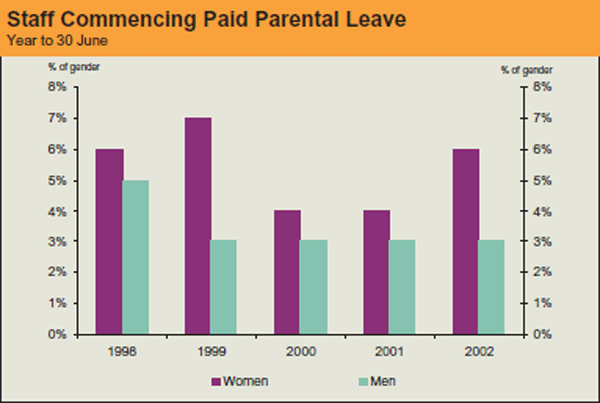
Women returning to work from parental leave during the reporting period were tracked to ascertain their use of part time work. Of the 13 who returned to work, 11 resumed part time and the majority of these worked part time for longer than the guaranteed initial period.
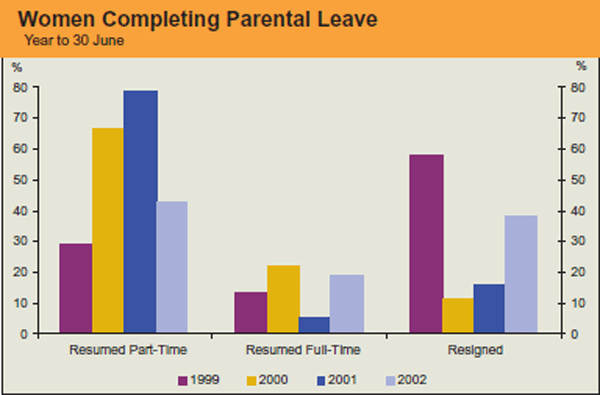
2.3 Indigenous Australians
Australian Bureau of Statistics (ABS) figures indicate that only 10% of Indigenous Australians complete Year 12, compared with 30% for the total population. The general educational requirements attached to most jobs in the Bank mean that the representation of Indigenous Australians continues to be quite low. There is a designated position under the Bank's traineeship program and as part of the new plan, the Bank intends to consider the Commonwealth Indigenous Cadetship Program.
2.4 Race-ethnicity
The Bank has monitored race-ethnicity in its previous reports by classifying people as being from a non-English speaking background (NESB). However, the Australian Public Service, through the Public Service Act 1999, no longer refers to people from non-English speaking background (NESB) as a designated group. Instead, the indicator of disadvantage is based on race-ethnicity. The Bank has now adopted this approach.
As yet, the Australian Bureau of Statistics has not finalised a specific measure for assessing diversity or employment-related disadvantage. In the absence of this measure, the Bank has sought to identify characteristics that might disadvantage staff in the workplace. The characteristics identified directly related to people from non-English speaking backgrounds (NESB1), that is, people born overseas and whose first language was not English. The Bank intends to revise the current New Employment form to better capture information regarding race-ethnicity during the next reporting period.
Although approximately 20% of staff have identified themselves as being from such a background it doesn't necessarily follow that they all suffer from disadvantage. Of these employees, 44% were located in the Bank's Corporate Services Group. In particular, they were heavily represented in the Bank's information technology, accounting and audit departments. Further analysis has shown that a characteristic of these clusters of employees is that they are generally more highly qualified than other staff in these departments, reflecting the nature of the employment market. To ensure that this group is afforded equal opportunity in career progression, data will be maintained on their occupational groupings for future development initiatives.
2.5 People with Disabilities
Currently, 2% of Bank staff have identified themselves as having a disability. As noted in last year's report, this figure may be conservative since the definition of a disability is subjective and fear or embarrassment may reduce the numbers who are willing to identify their disabilities. Furthermore, any disability acquired after commencing employment is not included as the data is only collected at recruitment. The Bank's Disability Action Plan has been incorporated into the Workplace Diversity Plan 2001–2005 and will undergo annual reviews to ensure strategies are implemented and new targets identified.
2.6 Summary of Diversity Plan Initiatives
Gender
- Monitor uptake of contracts by women and conduct further analysis on the identified gap between genders and classification levels.
- Review contract remuneration outcomes annually to track any significant variations between women and men in comparable positions. A detailed analysis of occupations by gender representation and remuneration will also be included in the review.
- Review, for effectiveness, specific initiatives associated with the Graduate Development Program designed to enhance the scope for advancement of female graduates into management positions over time.
- Monitor graduate recruitment gender ratio statistics and compare with university enrolment statistics. Provide the graduate recruitment team with relevant statistical data. Monitor gender ratio within the graduate applicant pool.
- Identify where succession plans might not adequately comprehend future retirements.
- Identify opportunities to encourage higher representation of women in management positions.
- Review ASCO codes during the next reporting period to ensure accuracy in classifications and data integrity. Monitor progress of women within professional occupations.
- Establish educational qualifications data integrity standards at recruitment stage.
Work Life Balance
- Launch Intranet site on Work & Family.
- Monitor use of flexible work arrangements.
- Release part time work information pack during next reporting period.
- Develop a formal Welcome Back program for women returning from parental leave.
- Investigate Working Parents Forums to provide networking opportunities for new parents.
- Use workplace profile analysis to review effectiveness of policies, for example, flexible work arrangements.
Indigenous Australians
- Investigate the feasibility of using the Commonwealth Indigenous Cadetship Program.
- Maintain designated traineeship position with mentoring support.
- Consider conducting Cultural Awareness Workshops.
- Highlight opportunities to recognise Indigenous culture, for example NAIDOC Week (July).
Race-ethnicity
- Revise the Bank's current equal employment opportunity form to better capture information on race-ethnicity.
- Increase opportunities for NESB1 employees to develop written communication skills.
- Highlight opportunities to recognise cultural diversity, for example, Harmony Day (March).
People with Disabilities
- Conduct Disability Awareness Workshop annually.
- Maintain designated traineeship position with mentoring support.
- Provide reasonable adjustment advice to departments employing people with disabilities.
- Review disability access and equity strategies annually. Evaluate, modify, and introduce, where necessary, initiatives to enhance effectiveness and relevance.
- Consider implementing self service access to the Bank's HR database to enable staff to update their personal information.